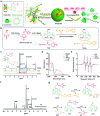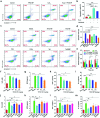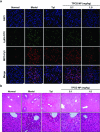A Broad-Spectrum ROS-Eliminating Material for Prevention of Inflammation and Drug-Induced Organ Toxicity
- PMID: 30356945
- PMCID: PMC6193162
- DOI: 10.1002/advs.201800781
A Broad-Spectrum ROS-Eliminating Material for Prevention of Inflammation and Drug-Induced Organ Toxicity
Abstract
Despite the great potential of numerous antioxidants for pharmacotherapy of diseases associated with inflammation and oxidative stress, many challenges remain for their clinical translation. Herein, a superoxidase dismutase/catalase-mimetic material based on Tempol and phenylboronic acid pinacol ester simultaneously conjugated β-cyclodextrin (abbreviated as TPCD), which is capable of eliminating a broad spectrum of reactive oxygen species (ROS), is reported. TPCD can be easily synthesized by sequentially conjugating two functional moieties onto a β-cyclodextrin scaffold. The thus developed pharmacologically active material may be easily produced into antioxidant and anti-inflammatory nanoparticles, with tunable size. TPCD nanoparticles (TPCD NP) effectively protect macrophages from oxidative stress-induced apoptosis in vitro. Consistently, TPCD NP shows superior efficacies in three murine models of inflammatory diseases, with respect to attenuating inflammatory responses and mitigating oxidative stress. TPCD NP can also protect mice from drug-induced organ toxicity. Besides the passive targeting effect, the broad spectrum ROS-scavenging capability contributes to the therapeutic benefits of TPCD NP. Importantly, in vitro and in vivo preliminary experiments demonstrate the good safety profile of TPCD NP. Consequently, TPCD in its native and nanoparticle forms can be further developed as efficacious and safe therapies for treatment of inflammation and oxidative stress-associated diseases.
Keywords: antioxidants; inflammation; nanoparticles; reactive oxygen species; targeted therapy.
Figures









Similar articles
-
Pulmonary circulation-mediated heart targeting for the prevention of heart failure by inhalation of intrinsically bioactive nanoparticles.Theranostics. 2021 Jul 25;11(17):8550-8569. doi: 10.7150/thno.61875. eCollection 2021. Theranostics. 2021. PMID: 34373758 Free PMC article.
-
Targeted Therapy of Atherosclerosis by a Broad-Spectrum Reactive Oxygen Species Scavenging Nanoparticle with Intrinsic Anti-inflammatory Activity.ACS Nano. 2018 Sep 25;12(9):8943-8960. doi: 10.1021/acsnano.8b02037. Epub 2018 Aug 21. ACS Nano. 2018. PMID: 30114351
-
Targeted Treatment of Ischemic Stroke by Bioactive Nanoparticle-Derived Reactive Oxygen Species Responsive and Inflammation-Resolving Nanotherapies.ACS Nano. 2021 Oct 26;15(10):16076-16094. doi: 10.1021/acsnano.1c04753. Epub 2021 Oct 4. ACS Nano. 2021. PMID: 34606239
-
Reactive Oxygen Species and the Aging Eye: Specific Role of Metabolically Active Mitochondria in Maintaining Lens Function and in the Initiation of the Oxidation-Induced Maturity Onset Cataract--A Novel Platform of Mitochondria-Targeted Antioxidants With Broad Therapeutic Potential for Redox Regulation and Detoxification of Oxidants in Eye Diseases.Am J Ther. 2016 Jan-Feb;23(1):e98-117. doi: 10.1097/MJT.0b013e3181ea31ff. Am J Ther. 2016. PMID: 21048433 Review.
-
Antioxidants Maintain Cellular Redox Homeostasis by Elimination of Reactive Oxygen Species.Cell Physiol Biochem. 2017;44(2):532-553. doi: 10.1159/000485089. Epub 2017 Nov 17. Cell Physiol Biochem. 2017. PMID: 29145191 Review.
Cited by
-
An Osteoimmunomodulatory Biopatch Potentiates Stem Cell Therapies for Bone Regeneration by Simultaneously Regulating IL-17/Ferroptosis Signaling Pathways.Adv Sci (Weinh). 2024 Sep;11(35):e2401882. doi: 10.1002/advs.202401882. Epub 2024 Jul 18. Adv Sci (Weinh). 2024. PMID: 39024121 Free PMC article.
-
Smart stimuli-responsive drug delivery systems in spotlight of COVID-19.Asian J Pharm Sci. 2023 Nov;18(6):100873. doi: 10.1016/j.ajps.2023.100873. Epub 2023 Dec 1. Asian J Pharm Sci. 2023. PMID: 38173712 Free PMC article. Review.
-
Pulmonary circulation-mediated heart targeting for the prevention of heart failure by inhalation of intrinsically bioactive nanoparticles.Theranostics. 2021 Jul 25;11(17):8550-8569. doi: 10.7150/thno.61875. eCollection 2021. Theranostics. 2021. PMID: 34373758 Free PMC article.
-
Editorial: Advances in the development of functional biomaterial nanosystem in tumor therapy and tissue regeneration.Front Bioeng Biotechnol. 2023 Apr 4;11:1195089. doi: 10.3389/fbioe.2023.1195089. eCollection 2023. Front Bioeng Biotechnol. 2023. PMID: 37082217 Free PMC article. No abstract available.
-
Pathologically triggered in situ aggregation of nanoparticles for inflammation-targeting amplification and therapeutic potentiation.Acta Pharm Sin B. 2023 Jan;13(1):390-409. doi: 10.1016/j.apsb.2022.07.013. Epub 2022 Jul 20. Acta Pharm Sin B. 2023. PMID: 36815041 Free PMC article.
References
LinkOut - more resources
Full Text Sources
Miscellaneous
